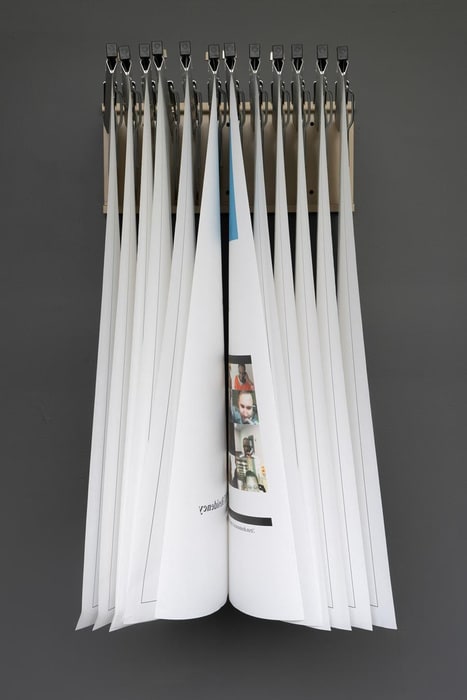
“The proliferating subaltern...indicates how the powers of the subject remain with us, that the strategies of the modern Will to Truth, the tools of science and history, remain the productive weapons of global subjection.”
– Denise Ferreira da Silva, author of 'Towards a Global Idea of Race'
The Toltecs, and later the Mexicans, believed that projection from the spiritual world into the physical was possible. Mahtactli on ce ilhuicatl or ‘the Eleventh Heaven’ is the location of the four spiritual energies of Tezcatlipoca, sometimes described as the ‘invisible god’ due to the scant surviving representations. Mahtactli on ce ilhuicatl is visualized by a square formation,[1] with each of the four spiritual energies occupying one corner, with scores of movement between intersecting lines of mother-thought and father-thought forming an x or cross in the center.[2] When enacted, the tracks rotate around the central axis, drawing a circle within a square. Far from the distance we see uses this geometric configuration and its spiritual significance to instigate audience participation, as the viewer must navigate the space according to predetermined routes in order to fully access the imagery contained within. Architecture elicits a compulsory performative equivalent to our contemporary experience of screen mediation.
A solo exhibition of new work, Far from the distance we see investigates various manifestations of physical and experiential confinement: Luna considers both corporeal confinement within the carceral state and the inescapable labor economy of late capitalism, alongside conceptual confinement within an imposed subject formation and position. The notion is explored both literally––through the specific embodied experience of moving through a constructed space––as well as through didactic and transcendental means. To fully experience the work, the viewer must navigate a complex site-specific structure packed with unlikely references to contemporary lived experience.
The architecture referencing Mahtactli on ce ilhuicatl contains a multi-channel video installation accessed via cubicle partitions treated with a privacy film designed to obscure only the content displayed on the video screens. The open concept cubicles reference an outmoded form of office space and economic stability, and the shift to precarious labor, not just by the artist as freelancer, but by workers in many fields across the global gig economy. The video-essay at the center begins with a digital calibration process based on a series of sequences used by marketing surveyors to establish a “baseline” for emotional response to consumed media. Luna’s video similarly seeks to create a baseline for interpreting the footage that appears after the calibration takes place. The installation necessitates two parallel forms of viewership: participants experience both watching unobstructed content, and watching others experience the same content made inaccessible by the privacy screen.
The essay format of the video is echoed in the inclusion of a draft of Luna’s essay Digital Deliverance: White Saviorism and the Screen. Installed as an experimental large-scale publication on a blueprint hanger for architectural drawings, this unusual presentation indicates a work-in-progress. In the essay, Luna critically evaluates the enthusiasm of the private sector to mediate human-to-human contact within the correctional, immigration, and healthcare systems. In analyzing advertisements for video-conferencing services in popular media, they draw on Althusser’s theory of interpellation to affirm that these forms of mediation apply to the same demographics of bodies. Considered an “accessible” and “affordable” alternative in response to the demands of overcrowded detention centers and a failing healthcare system, these methods render unmediated experiences such as in-person visitation and court proceedings, a privilege available for those outside of the marginal classes.
The sibling piece to Digital Deliverance,Touch-Trace is much smaller in scale. Deliberately eschewing the white gloves typically associated with the conservationist principles of the archive, this piece converges the legible with the tactile, and welcomes any residue left behind. Made of a shiny, non-toxic, mercurial-like metal, the work requires a small gesture – the participant’s touch – in exchange for an impermanent mark. The fingerprint, commonly associated with ‘booking’ in the criminal justice system, is no longer a record of an individual body but a traveling marker. Thus through the act of reading, the viewer embeds their biometric data onto the document, while the metal –which melts with body heat and solidifies at room temperature–becomes a temporary record, using the audience as a vehicle through which to enter the world outside the gallery.
The complex physical architecture and interwoven multi-media content of Far from the distance we see manufactures a viewing experience both intimate and alienating, reflecting the lived experience of the individuals for whom it was designed.
[1] Olivier, Guilhem, Mockeries and Metamorphoses of an Aztec God, Boulder: University Press of Colorado, 2008.
[2] Magaña, Sergio, 2012-2021: The Dawn of the Sixth Sun The Path of Quetzalcoatl: The Path of Quezalcoatl, Italy: Blossomingbooks, 2012.
Artist Bio
Mev Luna (b. Houston, Texas, 1988) is an interdisciplinary artist currently living and working in Chicago. Through a research-based practice and self-reflexive methodology, Luna’s practice rethinks history to identify the fictions that govern contemporary life and speculative futures. They work between live performance, video installation, new media, and text. Luna's works have been exhibited in group exhibitions at Oficina de Arte, México City; PRIZM Art Fair, Miami; Threewalls, Chicago; and the Oliver Arts Center, Oakland. Luna's time-based works have been presented at Artists' Television Access, San Francisco; MIX Queer Experimental Film Festival, New York, SFMOMA San Francisco; and Defibrillator Gallery, Chicago. Luna was a 2015-2016 fellow at the Shapiro Center for Research and Collaboration, a 2017 SOMA Summer participant in Mexico City, and a 2018 Art Matters Foundation Fellowship recipient.
This project is supported in part by a grant from the Illinois Arts Council, a state agency through federal funds provided by the National Endowment for the Arts.
Image: Mev Luna, Digital Deliverance: White Saviorism and the Screen, 2019.



